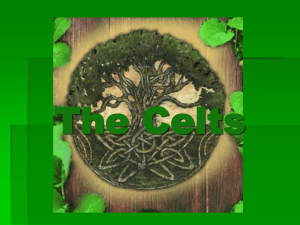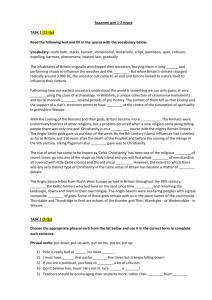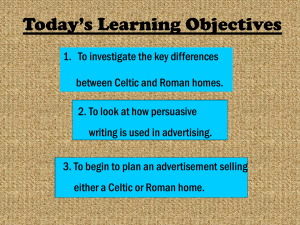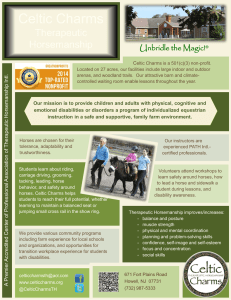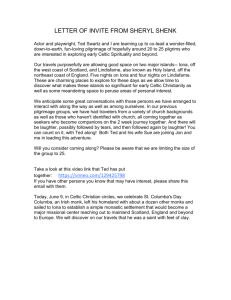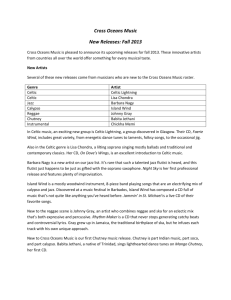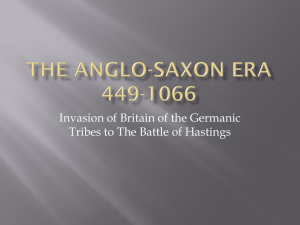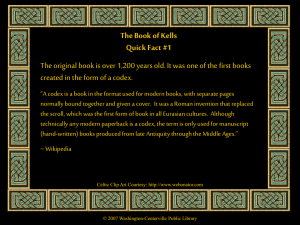Book of Kells - Macaulay Honors College
advertisement
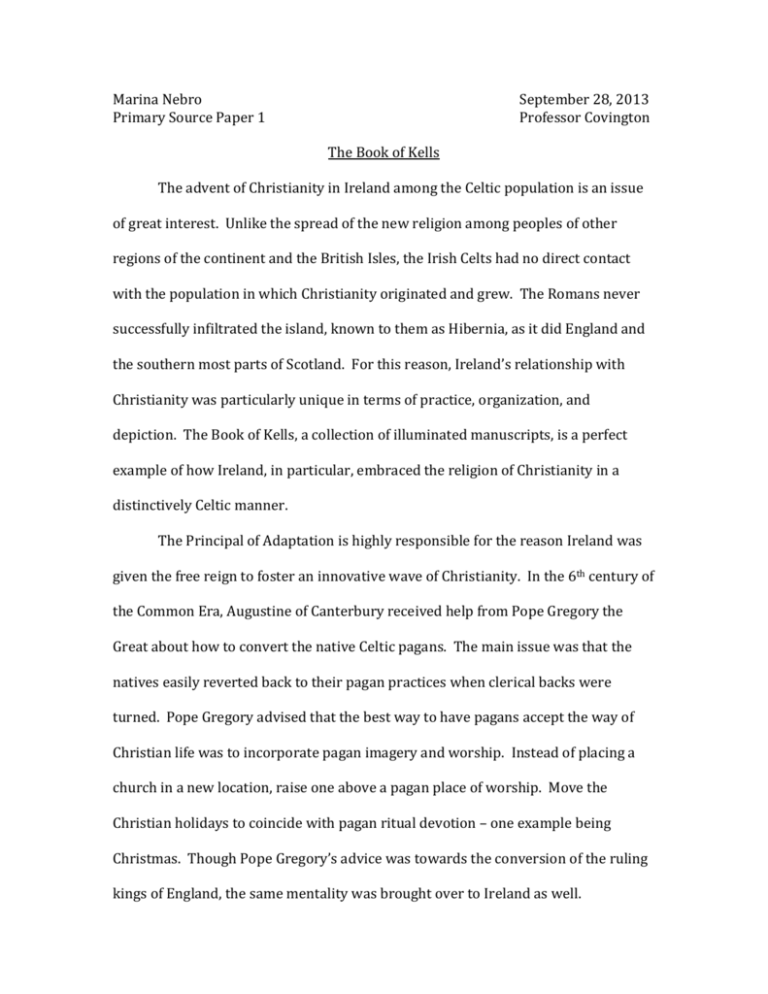
Marina Nebro Primary Source Paper 1 September 28, 2013 Professor Covington The Book of Kells The advent of Christianity in Ireland among the Celtic population is an issue of great interest. Unlike the spread of the new religion among peoples of other regions of the continent and the British Isles, the Irish Celts had no direct contact with the population in which Christianity originated and grew. The Romans never successfully infiltrated the island, known to them as Hibernia, as it did England and the southern most parts of Scotland. For this reason, Ireland’s relationship with Christianity was particularly unique in terms of practice, organization, and depiction. The Book of Kells, a collection of illuminated manuscripts, is a perfect example of how Ireland, in particular, embraced the religion of Christianity in a distinctively Celtic manner. The Principal of Adaptation is highly responsible for the reason Ireland was given the free reign to foster an innovative wave of Christianity. In the 6th century of the Common Era, Augustine of Canterbury received help from Pope Gregory the Great about how to convert the native Celtic pagans. The main issue was that the natives easily reverted back to their pagan practices when clerical backs were turned. Pope Gregory advised that the best way to have pagans accept the way of Christian life was to incorporate pagan imagery and worship. Instead of placing a church in a new location, raise one above a pagan place of worship. Move the Christian holidays to coincide with pagan ritual devotion – one example being Christmas. Though Pope Gregory’s advice was towards the conversion of the ruling kings of England, the same mentality was brought over to Ireland as well. The Book of Kells exemplifies how Celtic imagery and belief was translated into Christian practice. Motifs from Celtic mythology and decorative arts were copied into the illuminated manuscripts by the monastic society, creating a beautiful hybrid between two cultures. The page I would like to focus on is folio 27v, which depicts the four evangelists who wrote the four versions of the gospel: Mark, Matthew, Luke, and John. Throughout Christianity, different animals – lion, ox, and eagle – represent the evangelists. These particular animals are not unique to Celtic portrayal. In Revelations 4:6 – 7, it is said that there “are four living creatures, full of eyes in front and behind: the first living creature like a lion, the second living creature like an ox, the third living creature with a face like a human face, and the fourth living creature like a flying eagle.” This description is aimed towards the four evangelists. The depictions of men in the manuscript more often than not are very Irish Celtic in nature. Their hair is usually light – blonde, golden, or red – and unless a holy figure, their faces are often shaved. The animals, though not exclusive to Irish mythology, had significance in Celtic culture as well. The eagle is especially important in Celtic mythology as it is seen as one of the oldest creatures in existence. It represents wisdom, bravery, security, and peace. The Gaelic name for eagle is iolaire suile Na grein, which means “the eagle with the sunlit eye.”1 This description can easily be adapted into Christian practice. The eagle with the sunlit eye can easily communicate with God in heaven, and soar among the stars. The Celtic people were part of an agrarian society, and hence put a lot of importance into the land and nature. The bull or ox is a key figure in working the Puplett, Dan. “Mythology and Folklore of the Eagle.” Trees for Life. July 5, 2012. Web. September 28, 2013. <http://www.treesforlife.org.uk/forest/mythfolk/eagle.html> 1 land. Both these animals were known to be used in animal sacrifice and in ritual worship, though specifics about these practices are not known.2 While the eagle is a symbol for elevation, the bull or ox grounds the Christian religion to earth. The last symbol to talk about is the lion. In addition to being an agrarian society, the Celts were also known for their tribal, warrior traditions. The lion, winged in the image from the Book of Kells as it is elsewhere in evangelist iconography, is very similar to the dragon in Celtic mythology. This majestic feline represents bravery and strength, two characteristics very important to the Celtic warrior.3 Often times, the lion would be depicted on Celtic armor and weaponry, and even on decorative jewelry as well.4 Other than anamorphic iconography, the Book of Kells utilized many patterns and shapes prevalent in metalwork and decorative arts. The scrollwork, especially visible in folio 33r, is very similar to that seen on a lot of metal artifacts of the Celtic world.5 A very famous example of this metal scrollwork is the Tara Brooch on view at the National Museum of Archaeology in Dublin, Ireland. Instead of just being a decorative element, the eight circles on folio 33r form an intricate cross. This perfectly exemplifies a Celtic motif taken and transformed into Christian imagery. Throughout the entire manuscript, there are examples of Celtic knots. One very interesting knot is the contortion of a man, seen in many different positions, but particularly on the top left and bottom right corners of folio 27v. This imagery is not 2 Heinz, Sabine. Celtic Symbols. Toronto, Ontario: Sterling Publishing Company, Inc, 1999. 53-59. eBook. 3 Heinz, Sabine. Celtic Symbols. Toronto, Ontario: Sterling Publishing Company, Inc, 1999. 75-77. eBook. 4 Neckband. 100 CE. Artefact. ARTstorWeb. 28 Sep 2013. 5 Battersea Shield. 100-200 CE. Artefact. ARTstorWeb. 28 Sep 2013. new to the Book of Kells, and has been represented previously in works of decorative art.6 Without the influence of many other cultures on the growth of Christianity in Ireland, the religion was able to flourish and experience a golden age. In 7th century England, it was obvious that Irish Christianity and Roman Christianity differed. The Synod of Whitby (664), in which England had to choose which Christianity to follow, showed the differences in practices and ritual between the two Christian versions. With the Principal of Adaptation, the people of Ireland were able to maintain their Celtic culture while assimilating with the rest of Europe on a religious level. 6 Meehan, Bernard. The Book of Kells: An Illustrated Introduction to the Manuscript in Trinity College Dublin. 1st Ed. London: Thames & Hudson, 1994. 8-20. Print.
